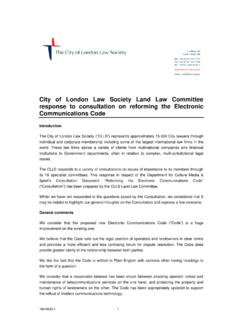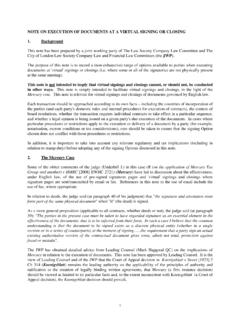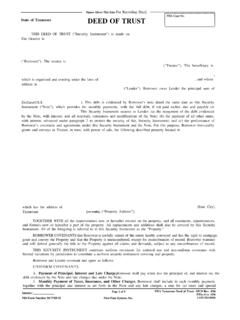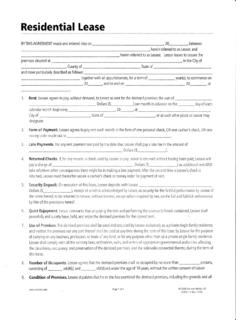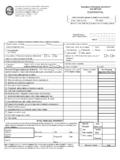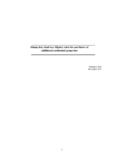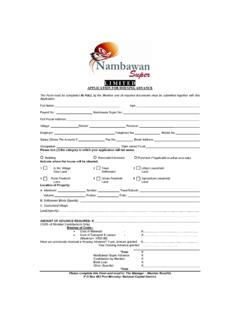Transcription of The Law Commission’s 13th Programme of Law …
1 1 The Law commission s 13th Programme of Law Reform THE leasehold REFORM ACT 1967 ( the 1967 Act ) THE HOUSING ACT 1974 ( the 1974 Act ) THE leasehold REFORM, HOUSING AND URBAN DEVELOPMENT ACT 1993 ( the 1993 Act ) THE HOUSING ACT 1996 ( the 1996 Act ) COMMONHOLD AND leasehold REFORM ACT 2002 ( the 2002 Act ) HOUSING AND PLANNING ACT 2008 ( the 2008 Act ) Purpose 1. The purpose of this paper is to demonstrate that leasehold enfranchisement is a topic that should be considered as a law reform priority, either in itself or as part of a wider review of residential leasehold law. leasehold Enfranchisement 2. The term leasehold enfranchisement has for many years been used to describe the principle that leaseholders should be enabled to become freeholders by the compulsory purchase of the fee simple of their holdings.
2 More recently, the expression has been expanded to encompass the general statutory rights now given to leaseholders to acquire superior interests and/or to acquire an extended lease. 3. The issue of leasehold enfranchisement has been a topic of debate going back to Victorian times. However, before the 1967 Act there were no statutes of a general nature which gave enfranchisement rights. The 1967 Act has now been with us for nearly 50 years. Originally intended to allow enfranchisement of lower rateable value houses, it was amended significantly by the 1974 Act (which introduced higher rateable value limits and allowed for marriage value in the valuation formula), again by the 1993 Act (which removed rateable value limits altogether), then by the 1996 Act (which removed the low rent test in respect of leases for a term in excess of 35 years), then by the 2002 Act (which further limited the circumstances where the low rent test applied and, in most cases, the residence test, as well as removing marriage value for leases with over 80 years unexpired)
3 And finally by the 2008 Act (which further modified the low rent test by abolishing it almost entirely for new leases). The 1993 Act introduced for flat owners with qualifying leases the collective right to enfranchise blocks of flats and the individual right to a lease extension. It was also substantially amended by the 1996 Act and again by the 2002 Act. 2 4. The principal purpose behind all this amending legislation was to try to make the enfranchisement process easier by reducing the qualification rules and simplifying the valuation process. Whether it succeeded is a moot point. The 2002 Act also attempted to make a collective claim fairer by giving all tenants the opportunity to participate in a claim through the mechanism of a Right to Enfranchise Company; however, those amendments have never been brought into effect because they are unworkable.
4 Criticisms - general 5. The legislation has been the subject of much criticism. This criticism can be divided into three main areas, although clearly they are each inter-linked. 6. First, there is the objection in principle to the whole concept of leasehold enfranchisement. It has to be said, however, that this element of the debate is now at an end it is principally a political issue and there is a clear consensus between the political parties that the concept of leasehold enfranchisement is here to stay. Furthermore, the principle of leasehold enfranchisement is generally accepted by landlords and tenants alike; the current focus should be therefore on making the system effective and fit for purpose. 7. Secondly, there is the criticism of the political process by which this legislation was passed.
5 The 1967 Act itself was passed on the basis of a political consensus on the need for leasehold reform. Although the product of a Labour Government, the Conservative opposition objected to the Bill, not on the principle, but on the provisions for compensation, which they considered, were confiscatory . The 1974 Act was very different and the history of its passage through Parliament makes sorry reading indeed. Little it seems was learnt from that experience in relation to the 1993 Act, the 1996 Act and the 2002 Act, each of which was a sad reflection on the parliamentary process. It is a classic example of tinkering with legislation; introducing a raft of amendments (some technical and some substantive), very often leading to unintended consequences.
6 8. The third area of criticism derives from the second area and relates to the contents of the several Acts. If there is legislation that is politically controversial, ill thought-out, often debated by people who have minimal understanding of the subject and very often drafted on the hoof , it is hardly surprising that it is full of errors, omissions and anomalies. Some of these errors, omissions and anomalies are within the individual Acts, whereas some relate to the 3 cross relationship between the Acts. Criticisms specific 9. There follows a summary of some of the criticisms that can be made of the legislation. It deals principally with the legislation as it stands; it does not seek to deal with some of the more fundamental issues of leasehold reform such as whether there is still a role for the extended lease under the 1967 Act (and if so, is it now fit for purpose); whether the statutory valuation should include marriage value; whether deferment rates or relativity should be prescribed; the relationship between the courts and the tribunals as the forums for resolving disputes etc.
7 (1) Qualification rules (a) Perhaps most strangely and despite four visits to the House of Lords and one (so far) to the Supreme Court (and numerous visits to the Court of Appeal) on the subject, there still remains considerable doubt as to the meaning of house in section 2 of the 1967 Act. This is a particularly good example of unintended consequences ; no thought was given to the impact on the statutory definition of house by the removal of the residence test as a condition of enfranchisement. (b) The 1993 Act contains no provisions currently in force regulating the relationship between the tenants of a building that qualifies for collective enfranchisement. The reason for that is that the provisions relating to a RTE company still sitting in the 2002 Act are unworkable in their present form.
8 These provisions should either be made workable or repealed. (c) Low rent. It is accepted that the circumstances where a low rent test still exists are now very limited. Nevertheless, in so far as it still applies to houses under the 1967 Act, there are criticisms that can be made. There are for example alternative tests depending on when the lease was granted and each test contains a number of different rules and conditions. Part of these tests depends on historic rateable values which can now often be very difficult to obtain. It is suggested that where there remains a need for a low rent test (is there?), there should be one simple test. 4 (d) Long tenancies: (i) The definition of tenancy is not the same in the 1967 Act as in the 1993 Act.
9 There does not appear to be any logical reason for this and it causes particular difficulties where sections have been added to the 1967 Act by the 1993 Act. (ii) In relation to long tenancies, although both the 1967 Act and the 1993 Act contain broadly similar provisions concerning statutory extensions, renewal tenancies and concurrent tenancies, only the 1967 Act allows consecutive long tenancies to be joined. There is no obvious reason for this differential. (2) Procedure (a) The 1967 Act has prescribed forms for a claim whereas the 1993 Act does not. The validity of notices given and received remains a fertile area for litigation. There is no reason not to prescribe forms of notice for the 1993 Act. (b) The 1993 Act includes provisions for the service of information notices.
10 There are no such provisions in the 1967 Act. (c) The 1993 Act requires the claimant to state an offer price both for a lease extension claim and a collective enfranchisement claim and for the counter-notice to state the landlord s counter-offer. There is no such requirement for a claim under the 1967 Act. (d) In the case of a lease being forfeit, leave of the court is required to serve a notice of claim under the 1993 Act but not under the 1967 Act. (e) Failure by the landlord to serve a counter-notice within the prescribed time-limit under the 1967 Act has no particular consequences, despite being in a prescribed form. It potentially has very severe consequences for the landlord in a new lease or collective claim. Furthermore, the counter-notice in a collective claim is required to state whether the premises are within an area of a 1993 Act scheme but not 5 whether they are within the area of a 1967 Act scheme.


